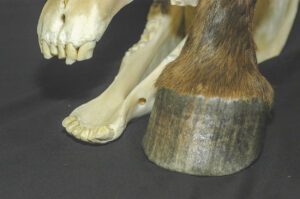Horse Hoof Anatomy: A Guided Tour

Learn how your horse’s feet work so you can understand how to keep them sound.
Clip. Clop. The simple hoofbeats of your moving horse effectively hide the highly complex anatomy and physiology at work inside his hooves during each step.
As a horse owner/caretaker, knowing the basics of hoof anatomy and physiology can help you keep your horses sound and bring them back from lameness more quickly. Plus, it certainly helps to understand what the heck your veterinarian and/or farrier are talking about if your horse comes up lame.
Andrew Parks, MA, Vet MB, MRCVS, Dipl. ACVS, head of the Department of Large Animal Medicine at the University of Georgia’s College of Veterinary Medicine, in Athens, puts it like this: “Understanding anatomy is a prerequisite to understanding physiology. Owners need to know what’s in the foot for many day-to-day reasons; for example, if the horse steps on a nail, they need to know what structures might be damaged so they know how serious it could be.” (Hint: A nail puncture in the middle third of the frog is particularly dangerous because the nail could damage several critical structures
Create a free account with TheHorse.com to view this content.
TheHorse.com is home to thousands of free articles about horse health care. In order to access some of our exclusive free content, you must be signed into TheHorse.com.
Start your free account today!
Already have an account?
and continue reading.
Related Articles
Stay on top of the most recent Horse Health news with

















